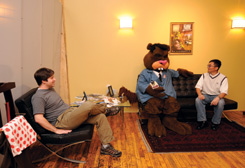They've Got Game
Tom Kang, AB’88, and Alex Seropian, SB’91, take video gaming beyond swordplay and shoot-’em-up.
By Benjamin Recchie, AB’03
Photography by Dan Dry
A cartoon hippopotamus and monkey fight and whirl about on an oversize computer screen in a loft office in Chicago’s West Loop. “I’m in the lead! I’m in the lead,” gloats Wideload Games president Thomas Kang, AB’88. His opponent is Wideload’s CEO and founder, Alex Seropian, SB’91, who isn’t giving up that easily. “You’re not in the lead any more!” taunts Seropian. “How’d you do that?” shouts Kang as he attempts to maneuver his hippo into position to pick up more points. But to no avail: Seropian’s simian takes the match.
The two men are playing Hail to the Chimp, the latest video game out of Wideload Games. It’s not the kind of video game that Seropian is known for—his previous company, Bungie, developed the blockbuster shoot-’em-up game Halo. But to listen to Seropian (and Kang, who freely describes himself as only a casual gamer), their animated animals might be a harbinger of the video-game world to come.
Seropian and Kang met in their fraternity, Phi Delta Theta. Seropian was following his interest in computer programming by pursuing a degree in mathematics with a concentration in computer science (the Department of Computer Science didn’t offer undergraduate degrees at the time). Shortly before graduating, he says, he was living on his father’s couch, debating whether to get a job or strike out on his own and form his own video-game company. He asked his father for advice. “His advice to me was to take a job with another company to get experience first. The next day I went out and started a company. My dad is a master of reverse psychology.”
Seropian’s company, Bungie Software Products Corporation, eventually set up shop in an apartment on Hyde Park Boulevard. It had a pair of successes in the form of the games Oni and Marathon; in 2000 Microsoft bought the company—and hired Seropian. Microsoft wanted Bungie’s next project, a first-person shooter, to become the flagship game for their new Xbox game system. That game, Halo, became a major success, spawning two sequels and solidifying Microsoft’s place in the video-game market.
While working for Microsoft, Seropian saw small game publishers struggle to keep up with the titans of the gaming industry, such as Microsoft and Electronic Arts (EA). The smaller shops would build a up a staff of 100 people or more—designers, writers, artists, and programmers—for the duration of a project, then lay them off afterward, only to have to scramble and rehire them when another project came along. The pressure that Microsoft put on game developers for the Xbox was causing many companies, as Seropian put it, to “burn out.” After leaving Microsoft in September 2002, he returned to Chicago. The next February he started Wideload Games, built around a new business model, one flexible enough to run circles around a major developer when it came to creating a new game.
Meanwhile, Kang, a chemistry major, had gone to work for Mobil, where he helped put together the huge 1999 Exxon-Mobil merger. In 2000, he was recruited as President and CEO of a Chicago-based sports management, marketing, and consulting firm, CSMG. Kang helped lead CSMG’s growth into one of the biggest such firms in the U.S.— a path that eventually led him back to Seropian when the two teamed up to make a video game featuring CSMG clients. Wanting to tap into the video-game market, which was growing faster than the markets for movies or music, Kang ended up leaving CSMG to become Wideload’s president.
“The traditional video-game studios, like EA, have a team structured with a design crew, engineering staff, and front-office staff,” says Seropian. “At EA, it’s 200 people. They’re all employed by the studio, and it’s like Hollywood in the 1940s.” By comparison, Wideload employs 25 people full time, with the remainder of the team hired as freelancers for a particular project.
His other novel idea was to expand into the untapped market for games in new genres. Seropian points out that although successful films can fall into many different categories—romance, action, comedy, drama, etc.—successful video games tend to be limited to combat, science fiction, or fantasy themes. Seropian saw a pent-up demand for games not aimed solely at “those dudes in the basement drinking Mountain Dew.” Most other games were aimed at men in their teens to their thirties, ignoring the sizeable buying power of middle-aged adults and women. Games that can appeal to them as well are “where gaming is going,” Kang agrees.
“Hail to the Chimp started as this idea that we can make a game for everyone that shared a lot in common with the things that we have developed during our past making a competitive action game,” says Seropian, adding that he wanted a video game he could play with his children. As the development team sifted through ideas in early 2006, they realized that an election theme could be fertile—and timely—grounds for comedy.
The plot of Hail to the Chimp revolves around the animal world’s attempt to elect a new leader to succeed their abdicated king, the Lion. The “candidates” are a motley crew, from a samurai octopus to a walrus who speaks only in classic-rock lyrics (including, you guessed it, “I Am the Walrus”). With each player assuming the role of a different animal, campaigns take the form of comical free-for-all fights in which two players can team up temporarily to knock an opponent down a peg. This cooperative play, says Seropian, is integral to the model of Hail to the Chimp as a party game, as players need to interact with another person (either online or in their living room) to get ahead.
Between bouts, players get updates on their standings in the game via a simulated CNN-like TV network called GRR (“It stands for ‘grr,’” deadpans Seropian), read by an animal version of Walter Cronkite named Woodchuck Chumley. Along with the score, GRR also serves as a medium for jokes, both delivered by Chumley and by the ticker at the bottom of the screen (“Pandas Bamboozled by Obesity Epidemic”). If the player lets Chumley talk long enough, GRR will break for a mock commercial (“Beaver’s Bend College of Dam Design”).
While getting mixed reviews from hardcore gamers, Hail to the Chimp was well received in the more general market (the Web site GameSpot gave it a middling 5.5/10, but the Philadelphia Inquirer called it “insanely enjoyable”), which Kang describes as having the most potential for growth in the gaming industry. Meanwhile, Seropian and Kang’s efforts to create their new paradigm in game development has spawned imitators; Seropian points out that even EA has started to reorganize its regional studios along Wideload’s pared-down lines.
Although video games have become commonplace with the young, they as yet have limited currency with older generations. Despite Seropian and Kang’s best efforts, the electronic pastimes they create may always remain so. But if you end up playing a party game on an Xbox or a Nintendo Wii at your great-uncle’s retirement party in a few years, you’ll know who had a hand in making it a reality.



